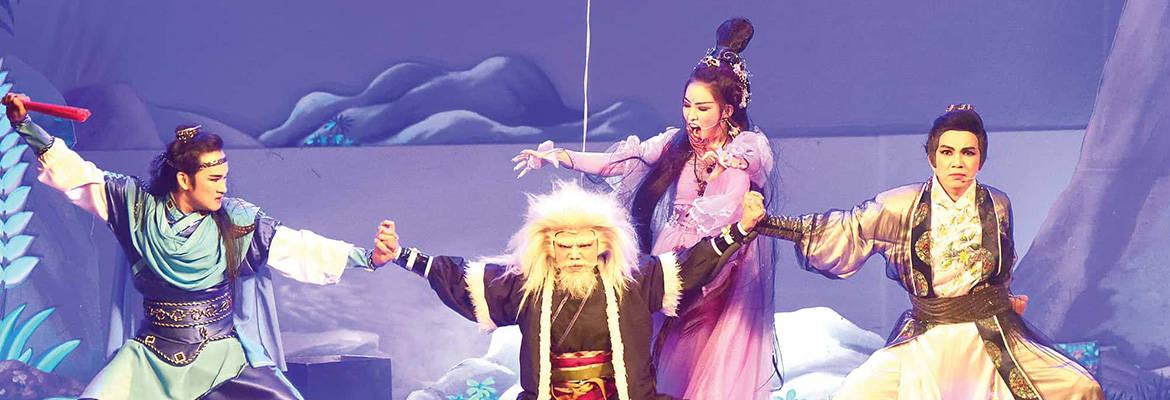✩⡱ one last music culture: vietnamese cải lương!
For the semester's last week, we were assigned to teach each other about something we haven't learned yet - naturally, I thought of Vietnamese "cải lương"!
The musical genre "cải lương" is something I've grown up hearing and watching in different settings, whether it be watching it at a family friend's house on the TV, or hearing an auntie sing it.
I know of this genre because of my heritage, so much of the information I am drawing from comes from both personal knowledge and various Vietnamese-tourist sources.
"Cải lương" is both a musical art and genre from Vietnam, roughly translated to "renovated theater". Its name's origin comes from it being a combination of three things: "tuồng", which is southern Vietnamese folk music and Chinese-based classical theater form, Asian popular theatre, and French comedy - this shows how big of an impact European (French) colonialism affected Vietnam and its culture.
Old, established, Vietnamese classical theatre (hát tuồng) was transformed with French colonialism. Cải lương somewhat resembled European comic opera, with its blend of dialogue and song (like a play). With cải lương performed in European-style playhouses in South Vietnam's village squares, the productions made much use of scenery, stage properties, and theatrical costumes.
While dating back to the 20th century and cải lương being performed in South Vietnam's village squares, it became a middle-class form of theater in the 1930s. Although cải lương is popular over all of Vietnam, it's most popular in the southern heartland.
Listening to folk music sang by locals resonates with many lower class people in Vietnam, as its like looking at, and hearing, their own lives through everyday words and simple melodies. It is the feeling of familiarity and nostalgia that makes cải lương folk music so popular among the working class of Vietnamese, especially with much of the working class being more elderly.
The content of cải lương plays are often derived from old stories such as Behead Trinh An, wife of Ngu Van Thieu was darted, Thoai Khanh-Chau Tuan, etc.
It originates from the area of the Mekong Delta (a river), where it is still a largely popular traditional art performance.
Although cải lương is popular, and became popular in the 1930s, it had a major setback in popularity around the 1980s. This was due to televisions and TV programs becoming popular, causing people to go out less to attend performances. Instead, people wanted to stay at home instead. In the 60s of the 20th century, actors mixed singing with dancing, flying, martial arts to try to make the performances more lively.
Despite this, there have been efforts to revive cải lương's popularity like before - its popular now, but not as popular as before.
----
There are two types of cải lương - "cải lương tuồng cổ", the ancient form, and "cải lương xã hội", which is more modern. With the more modern version, cải lương xã hội, having performances dealing with romantic, domestic relationships centering on the cultural and social norms of the country, its stories usually include more of modern Vietnamese society.
Cải lương tuồng cổ is characterized by performers dressed in old-fashioned costumes, with story plots being about legendary and historic tales of the feudal system.
The principal supporting songs in cải lương is the "vọng cổ", which literally means “nostalgia for the past”. It's a special type of singing, accompanied with background music of either the “Đàn tranh” (16-chord zither) or the guitar. Oftentimes, the audience watching will gasp, or react, to hearing the vọng cổ's first few bars, as they recognize it.


This blog was so interesting! I had never heard of the cai luong before, and it was so great to learn about something so different yet so similar to some of our art forms, in terms of plays. Cai luong is so visually interesting, and its syncretic creation with French influence was so cool to learn about. Cai luong looks so beautiful and it was especially to learn about the song speak and other lyrical aspects.
ReplyDeleteWow, this post is so informative! I learned so much about cải lương! First of all, the costumes look SO cool. I also thought it was super interesting that cải lương is more popular with the working class of Vietnam, because I think most theatre styles these days usually don't have that association. I do have a question, if you're able to answer! As a tonal language, do the melodies in Vietnamese tend to follow the tones, or are the they mostly dropped in music?
ReplyDeletehi claryn!! ofc i can answer your question <3 the melodies do follow the tones - since viet is a tonal language, a lot of words are spelled w the same letters, but they have diff accents. for example, "má" would be mother, and "ma" would be ghost. so in songs, there's still that accent/changing tones in diff words, making the melodies go along w the words. i hope that answers your question. some viet artists i love are min, son tung mtp, and bich phuong if you wanna listen to some!!
Delete